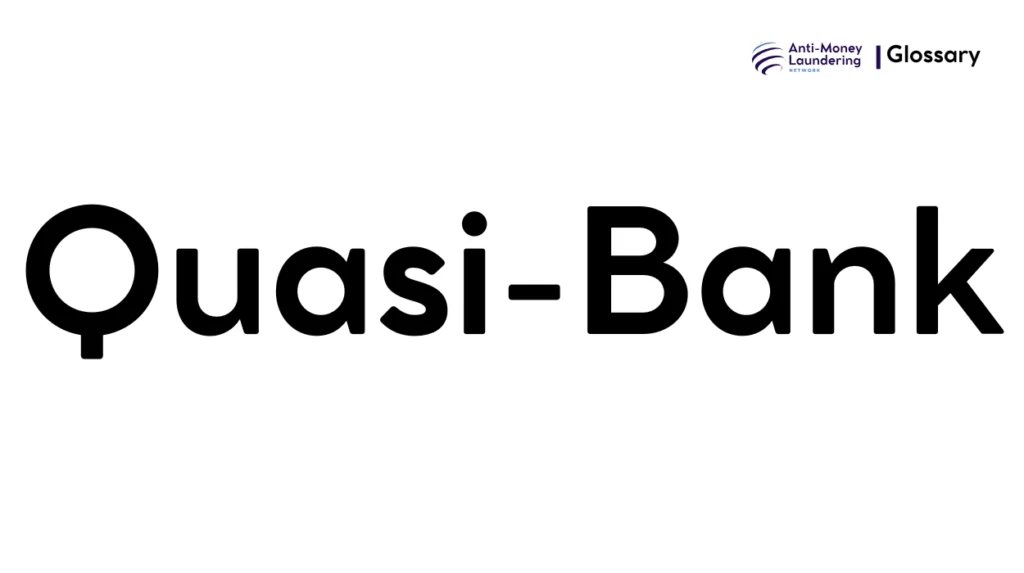Definition
A Quasi-Bank in Anti-Money Laundering (AML) terms refers to a non-bank financial institution or entity that performs banking-like or financial intermediation functions without being a fully licensed bank. These entities engage in activities such as deposit-taking, lending, payment services, or investment facilitation that resemble banking operations, hence they are subject to AML regulations designed to prevent misuse for money laundering or terrorist financing.
Purpose and Regulatory Basis
The concept of a quasi-bank matters in AML because such entities can be exploited to launder illicit proceeds if left unregulated. They fill gaps in the financial ecosystem but may operate outside the full regulatory scrutiny banks face. Consequently, AML frameworks globally and nationally emphasize monitoring and regulating quasi-banks to ensure they implement strong anti-money laundering controls.
Key regulatory frameworks include:
- Financial Action Task Force (FATF) Recommendations, which set international standards for AML and counter-financing of terrorism (CFT), urging member countries to regulate all financial intermediaries, including quasi-banks.
- USA PATRIOT Act, which broadens AML obligations to certain non-bank financial institutions, requiring customer due diligence and suspicious activity reporting.
- European Union Anti-Money Laundering Directives (AMLDs), which define and regulate entities that perform quasi-banking services to mitigate ML/TF risks.
These regulations collectively ensure that quasi-banks operate in compliance with AML standards comparable to those of fully licensed banks.
When and How it Applies
Quasi-bank AML regulations apply when a financial institution or entity performs quasi-banking functions such as:
- Accepting deposits repayable on demand or at short notice.
- Granting credit or loans.
- Providing payment and money transfer services.
- Managing portfolios of securities or investments.
For example, investment houses, finance companies, microfinance institutions, and certain fintech firms may be categorized as quasi-banks if they undertake such functions, triggering AML obligations.
Regulators typically require licensing or registration of quasi-banks and impose AML controls including customer identification, transaction monitoring, record keeping, and suspicious activity reporting.
Types or Variants
Quasi-banks may come in various forms, depending on jurisdiction and business focus:
- Investment Houses: Entities that provide investment advisory and portfolio management but also engage in credit operations.
- Finance Companies: Firms offering loans or credit facilities without full banking licenses.
- Microfinance Institutions: Organizations that provide small loans and payment services, particularly in underserved markets.
- FinTech Companies: Non-bank digital platforms that facilitate payments, lending, or fund transfers.
Each type performs distinct quasi-banking functions but shares the common AML compliance requirements due to their financial intermediation role.
Procedures and Implementation
To comply with AML obligations, quasi-banks must implement:
- Know Your Customer (KYC) and Customer Due Diligence (CDD): Verifying customer identities, understanding their business profiles, and assessing ML/TF risk.
- Transaction Monitoring: Using systems to detect unusual or suspicious patterns indicative of money laundering.
- Record Keeping: Maintaining comprehensive records of transactions and customer information for a regulatory retention period.
- Reporting: Filing Suspicious Transaction Reports (STRs) or Suspicious Activity Reports (SARs) to relevant financial intelligence units.
- AML Policies and Training: Establishing internal AML policies, appointing compliance officers, and conducting ongoing employee training.
Institutions often adopt technology solutions like automated monitoring software combined with manual reviews to effectively manage risks.
Impact on Customers/Clients
From a customer perspective, quasi-bank AML compliance means:
- Enhanced identity verification and documentation requirements.
- Possible transaction delays due to due diligence and monitoring procedures.
- Restrictions on certain types of transactions deemed high-risk.
- Rights to privacy balanced against regulatory mandates for transparency.
Clients must cooperate by providing accurate, verifiable information and understanding that AML controls protect the integrity of the financial system.
Duration, Review, and Resolution
AML obligations for quasi-banks are ongoing. Key points include:
- Duration: AML measures apply for the entire duration of the client relationship and through the lifecycle of accounts or transactions.
- Review: Institutions must periodically review customer risk profiles and update due diligence accordingly, typically annually or when risk indicators change.
- Resolution: If suspicious activities are detected, institutions must escalate through internal investigations and report to authorities as mandated.
Reporting and Compliance Duties
Quasi-banks bear significant responsibilities, including:
- Developing AML compliance programs aligned with regulatory standards.
- Designating an AML compliance officer responsible for oversight.
- Documenting all AML checks, decisions, and reports to demonstrate compliance.
- Undergoing regulator audits and examinations aimed at verifying AML adherence.
- Facing penalties, fines, or license revocations in case of non-compliance or enforcement actions.
Related AML Terms
Quasi-bank AML requirements intersect with several AML concepts:
- Customer Due Diligence (CDD) and Enhanced Due Diligence (EDD) for higher-risk customers.
- Suspicious Activity Report (SAR) / Suspicious Transaction Report (STR) filings.
- Trade-Based Money Laundering (TBML), as quasi-banks might be involved in trade financing.
- Beneficial Ownership Identification, critical to understand ultimate ownership behind accounts.
Challenges and Best Practices
Common challenges for quasi-banks include:
- Balancing comprehensive AML controls with customer experience.
- Managing high volumes of transactions with limited resources.
- Keeping up with evolving regulatory requirements.
- Detecting complex money laundering schemes involving layered transactions.
Best practices involve:
- Implementing risk-based approaches tailored to customer profiles.
- Leveraging technology like AI-driven transaction monitoring.
- Continuous compliance training and awareness programs.
- Engaging with regulators proactively for guidance and audits.
Recent Developments
AML compliance for quasi-banks is evolving with:
- Increased regulatory scrutiny post-global AML reforms.
- Adoption of RegTech solutions to automate KYC, monitoring, and reporting efficiently.
- Expanding coverage to include emerging fintech models and digital assets involved in quasi-banking activities.
- Enhanced international cooperation to track cross-border laundering involving quasi-bank channels.
Quasi-banks are vital but potentially vulnerable financial intermediaries that play a key role in AML compliance frameworks. Understanding their functions, regulatory obligations, and AML best practices helps compliance officers effectively mitigate money laundering risks. Proper regulation and implementation of strong AML controls ensure these entities contribute to the integrity and stability of the global financial system.

